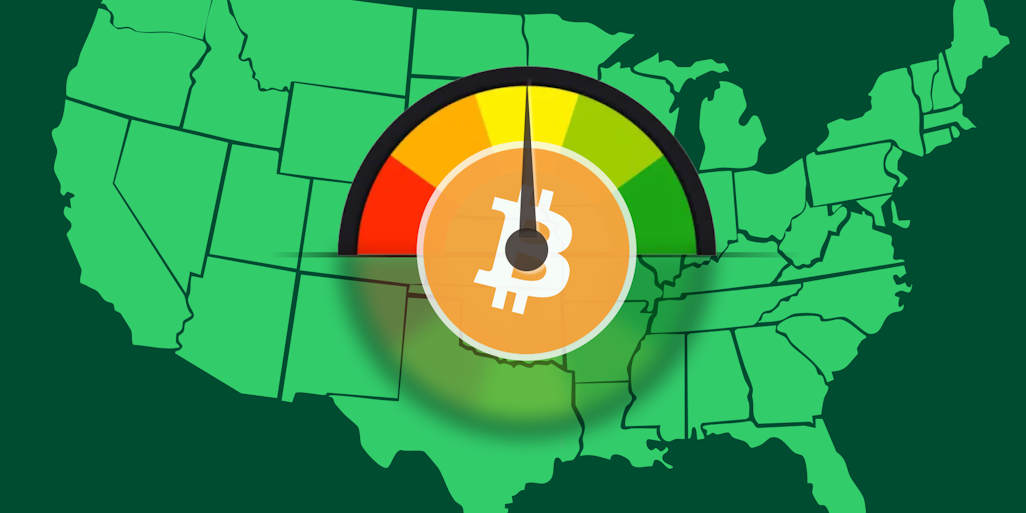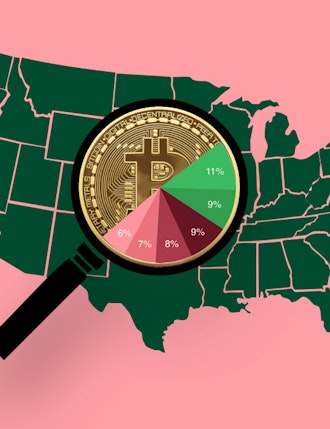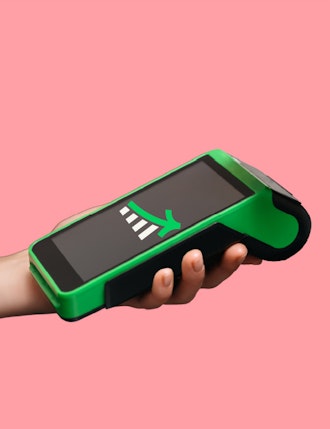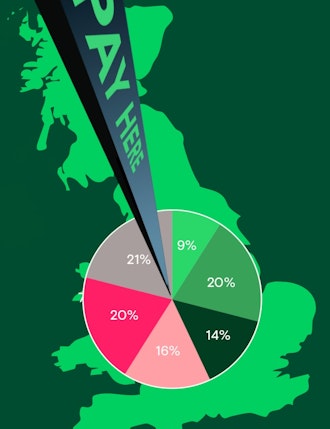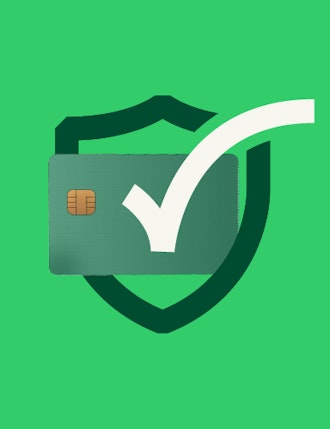Key Insights
-
The impact of digital currencies on consumer behaviour may depend more on age than most retailers realise.
-
The most common concerns around digital currencies may run deeper than usability alone.
-
One group shows notably less trust and more resistance to digital currencies across most metrics.
-
Trust in cryptocurrencies and CBDCs declines sharply with age, but that’s not the only generational divide.
- A surprisingly large share of Americans have already made up their minds about one particular kind of digital currency.
Don't have time to read more now? Sign up to our newsletter to get the latest insights directly in your inbox.
In our latest research, we surveyed 3,008 adults across the US and the UK, uncovering the widening gap between awareness and understanding of digital currencies in the US. But awareness alone isn’t what determines adoption. This US-focused report turns the spotlight on another core challenge: trust.
Beyond familiarity, we wanted to know whether people actually feel confident using digital currencies, and what fears or hesitations might be holding them back. In short, do people actually trust digital currencies enough to use in real world payments? Do they believe crypto is here to stay or is it too risky to touch? And what’s standing in the way?
The concept of security is as emotional as it is rational, especially in the world of finances and consumer behavior. Trust, or the lack of it, may be the single biggest force holding crypto and CBDCs back from mainstream life.
If a business such as a shop, café or website accepted digital currency payments, would you be more likely to shop there?
More than half of Americans (51%) say that a business accepting digital currencies as an additional payment option would make no difference in whether they choose to shop there. Another 8% say it would actually make them less likely to buy.
But the outliers tell a slightly different story. Among adults aged 25–34, a majority say they’d definitely or possibly be more likely to shop at crypto-accepting businesses. Interest is even higher among 18–24s, at 60%, before dropping off steeply among older adults: just 15% of those over 55 say the same.
When we break down preferences by type of purchase, a clear pattern emerges: younger adults are far more likely to say they’d use digital currencies for online purchases than for in-person transactions. For example, 16% of 18–24s and 13% of 25–34s say they’d “definitely” use crypto online, compared to just 1–2% of those aged 55 and over.
Top worries around digital currency use, by age:
In contrast, interest in using digital currencies in person remains low across all age groups, peaking at just 5% among the youngest group, whereas the “for all purchases” category follows a similar age trend: stronger among younger adults and nearly absent among older ones. These gaps suggest that crypto adoption may hinge on contexts where digital-native habits are already entrenched.
“Gender remains a consistent dividing line. 45% of men say they’d be more likely to shop at a business that accepts crypto, compared to just 38% of women.”
Top worries around digital currency use, by gender:
When comparing highly populated states, North Carolina showed above-average openness to in-person crypto transactions (+9% national average), indicating conditional openness to digital currencies in real-world retail that’s not yet common nationwide. Illinois on the other hand, is above average in total engagement across multiple categories (e.g., “Possibly for all” +5%, “Online” +6%).
If you already use digital currencies, what makes it appealing? If you don’t, what would persuade you to start?
When we asked Americans what might persuade them to start using digital currencies, the message was clear: practical benefits matter more than novelty.
“23% of millennials and 22% of zoomers named simpler payment processes as their top driver, making it the top driver overall at 17%”
Better security and fraud protection came in slightly higher overall at 19%, while lower fees were named by 15% of respondents.
Other motivators, like government backing or peer influence, were far less compelling. Only 7% said a government-issued option would persuade them, and just 9% mentioned friends or family as a factor.
Current and potential drivers of digital currency adoption, by age:

But what really stood out was how many said nothing could change their minds: 22% of women, versus 19% of men, said they would never consider using crypto under any circumstances. That figure rose dramatically with age, reaching 50% among those 65+.
Current and potential drivers of digital currency adoption, by gender:
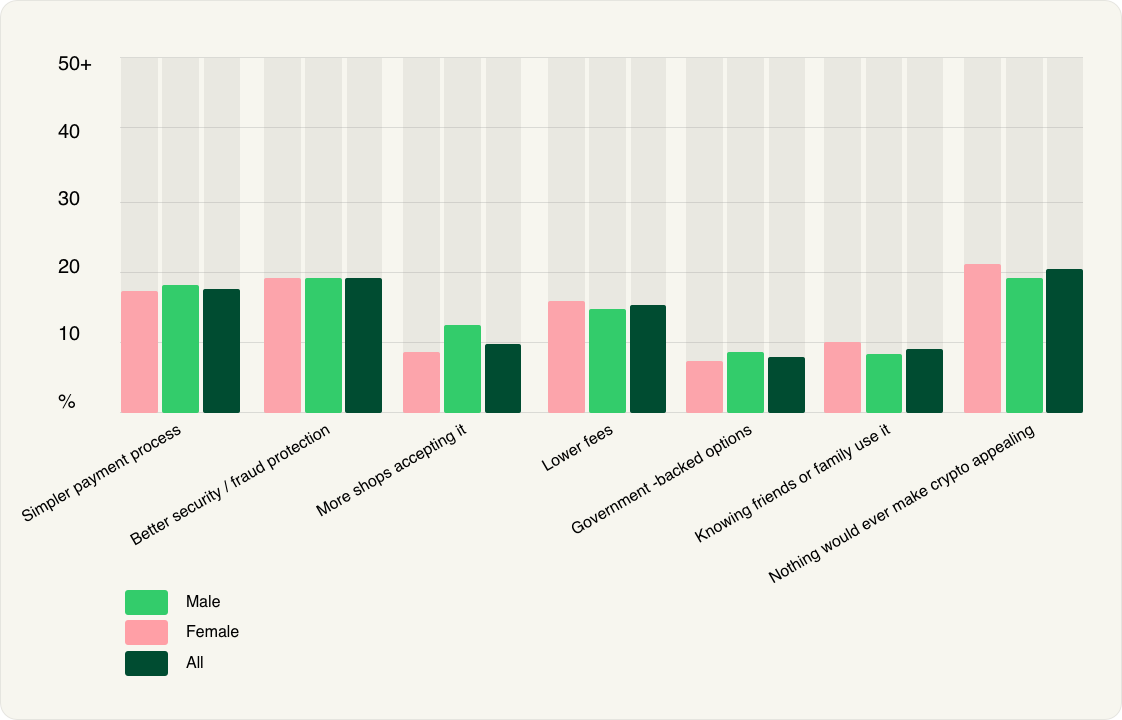
Texas emerged as a key opportunity market, respondents there were notably more motivated by core value propositions like simplicity (+6%) and cost through lower fees (+8%). Illinois also stood out for positive signals on security and usability (both +5% above average). By contrast, California, while a global tech leader, reported a stronger emphasis on security (+6%) and lower fees (+7%), as well as some high skepticism including a large share of respondents saying nothing would persuade them to adopt crypto (33%).
How much do you trust digital currencies as a safe and legitimate way to pay?
Here we come to the crux of the matter: when it comes to trust, cryptocurrencies remain polarizing. Just 36% of Americans say they trust them “a fair amount or more,” while the majority, 52%, say they trust them either “not very much” or “not at all”. The rest remains disengaged.
U.S. consumer trust in CBDCs and cryptocurrency:
Consistent to prior findings, younger adults showed the highest trust levels, with 51% of 18–24s and 45% of 25–34s expressing moderate or high trust. That trust drops significantly among older groups, with just 14% of those 65+ saying the same.
Once again, men were far more likely to trust crypto: 45% reported some level of trust, compared to 30% of women.
Meanwhile, the public sentiment toward CBDCs is slightly more neutral, but no more confident. Only 31% of Americans said they trust CBDCs “a fair amount or more.” Meanwhile, 48% said they trust them “not very much” or “not at all” A significant 20% said the question doesn’t apply to them, reflecting widespread unfamiliarity.
As with cryptocurrencies, trust declines steadily with age. Among adults 18–34, over 40% expressed some level of trust. That dropped to 14% in the 65+ group.
Men, once again, reported decisively higher trust levels than women 38% versus 26%, respectively.
“This isn’t only a matter of familiarity. For many, the emotional undercurrent is clear: crypto feels volatile, opaque, and risky. Typically, such traits don’t inspire long-term confidence.”
U.S. consumer trust in CBDCs by state:
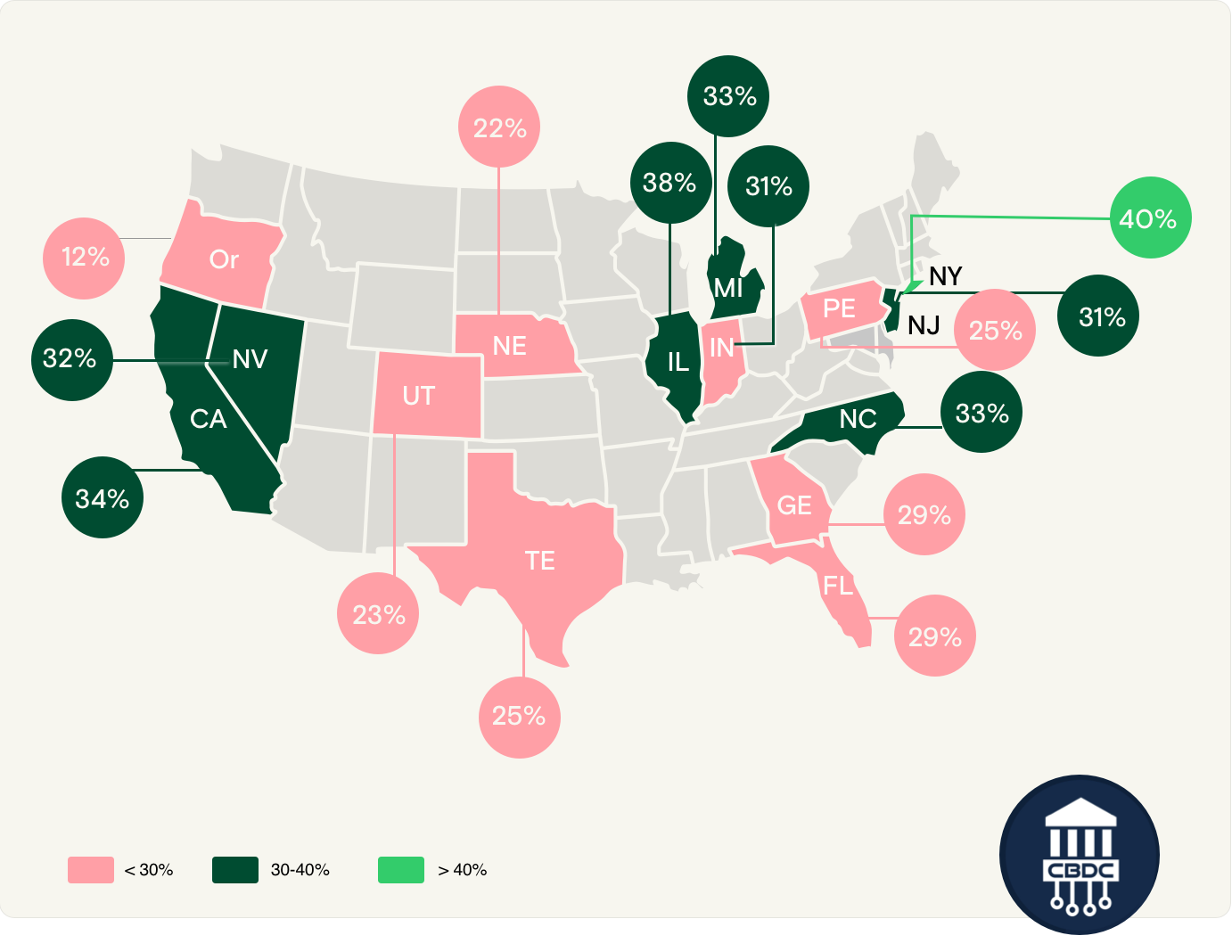
U.S. consumer trust in cryptocurrency by state:
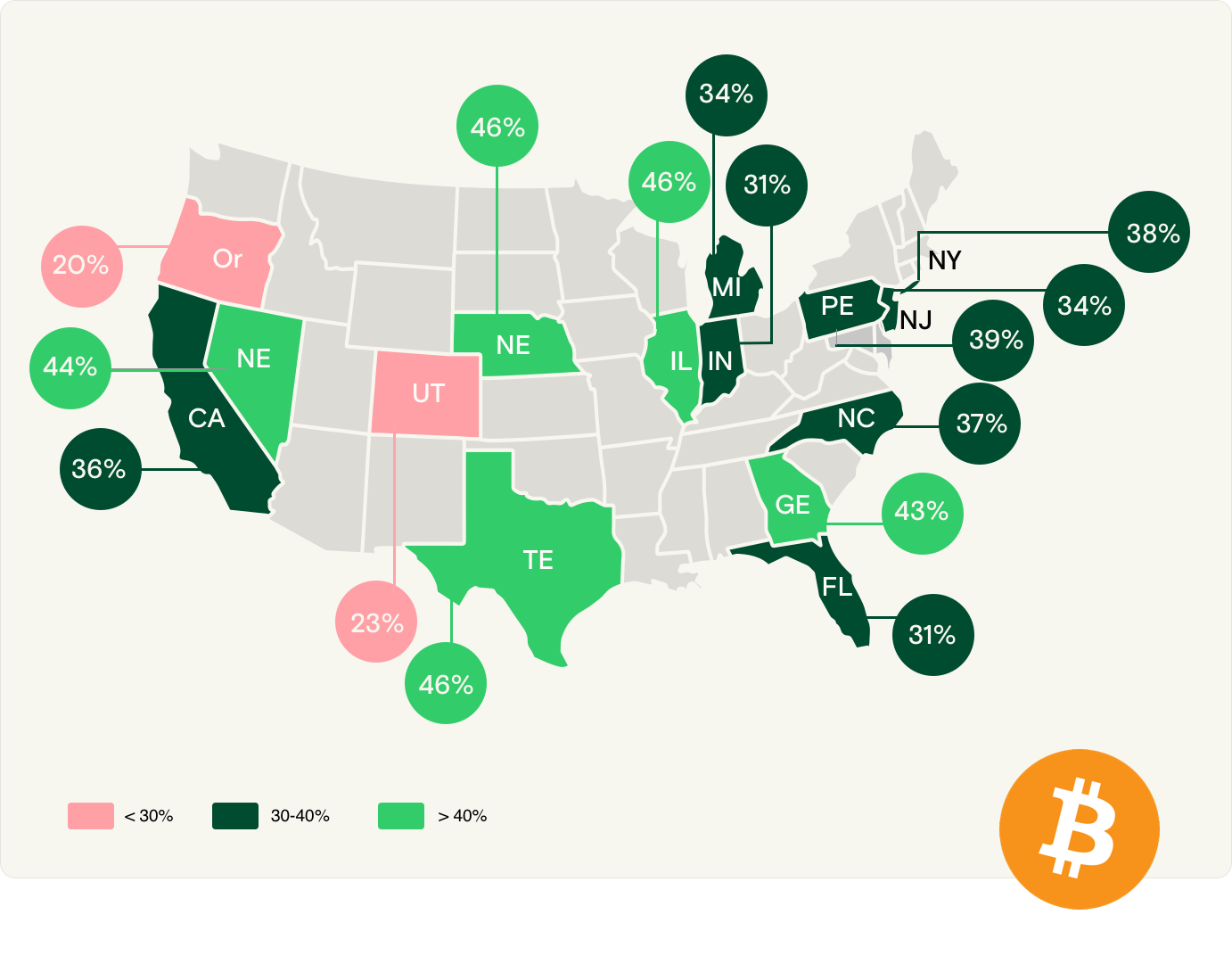
What are your biggest concerns about using digital currencies?
Security and control dominate the list of concerns with 24% citing fears of being hacked, scammed, or defrauded. Other major barriers, such as losing access to funds were overall as compelling as the lack of regulation, both coming up at second place with 20%.
Top worries around digital currency use, by gender:
The results seem to indicate something deeper than surface-level concerns around access or features, but appear instead to be emotionally rooted in uncertainty, especially for those who have limited familiarity with tech-based systems.
“The idea of irreversible loss, be it from human error or system failure, is bound to provoke strong hesitation.”
Top worries around digital currency use, by age:
Interestingly, the matter of privacy ranked lower overall at 13%, but it was more top-of-mind for younger users. Among 18–24-year-olds, 16% cited tracking and surveillance concerns, more than in any older group, suggesting younger users are more attuned to digital tracking risks.
Would you invest in celebrity-themed cryptocurrencies?
In recent years, celebrity-themed cryptocurrencies and meme coins briefly pushed crypto into the cultural mainstream. At their peak, celebrities like Caitlyn Jenner, Jason Derulo and Iggy Azalea even created their own tokens (think “Mother Iggy”), which fueled viral speculation and briefly made crypto a pop‑culture obsession.
The trend hit a new level when US President Donald Trump took it mainstream via the $TRUMP meme coin, launched on the Solana blockchain in January 2025. It soared into the top 20 cryptocurrencies by market value almost instantly stirring political buzz and speculative frenzy only to spark criticism over volatility, controversy, and alleged pump‑and‑dump schemes.
Yet despite the visibility of these coins, our survey suggests the public isn’t buying into the hype. Here, the rejection was nearly universal with 55%. Of these, 56% of women and 54% of men said they would not invest in any celebrity‑themed digital currency...
States like California, Georgia, Illinois, and Florida, often considered as innovation hubs, showed above-average rejection rates. These results suggest that consumers are looking for utility, not spectacle. Flashy branding cannot compensate for low trust.
Summary:
While awareness of digital currencies is growing, trust may lag behind. Our results show that most Americans still feel uneasy about using crypto or CBDCs as an integral part of their financial lives and routine.
Women are significantly less likely to trust, adopt, or feel persuaded by digital currencies compared to men. Across almost every trust and motivation metric, women consistently report lower confidence and higher resistance.
Younger adults on the other hand, are the most open to digital currencies, especially those aged 25–34, who show above-average trust levels and a higher likelihood to shop at crypto-accepting businesses. But even this group cites security, simplicity, and ease of recovery as non-negotiable requirements. Interest is high, but confidence is highly conditional.
State-level trends highlight pockets of early adoption, particularly Texas and North Carolina showing higher trust and interest in practical crypto usage. Meanwhile, California, Florida, and Indiana show above-average resistance.
When it comes to motivation, the top drivers are clear: simpler payment processes and better fraud protection are top of the list, instead of hype or social proof. On the flip side, privacy concerns remain secondary overall, but are more pronounced among younger respondents.
Americans aren’t looking for more crypto features or gimmicks. They’re waiting for reasons to believe in a viable and ‘more concrete’ future. Without emotional credibility, digital currencies will remain stalled or confined within a niche: technically capable but culturally untrusted.
Think you’ve got a handle on digital currencies? Put your knowledge to the test with this quiz.
Methodology:
This report draws on a nationally representative survey of 2,004 adults across the United States. The sample was balanced by key demographics, including age and gender, to ensure broad representativeness.
State-level figures were weighted in line with actual US population distributions. Only states with a sufficiently robust sample size were included in the state-by-state analysis, primarily covering the country’s most populous regions.
Interested in reading more around this subject? Here are some useful articles…
